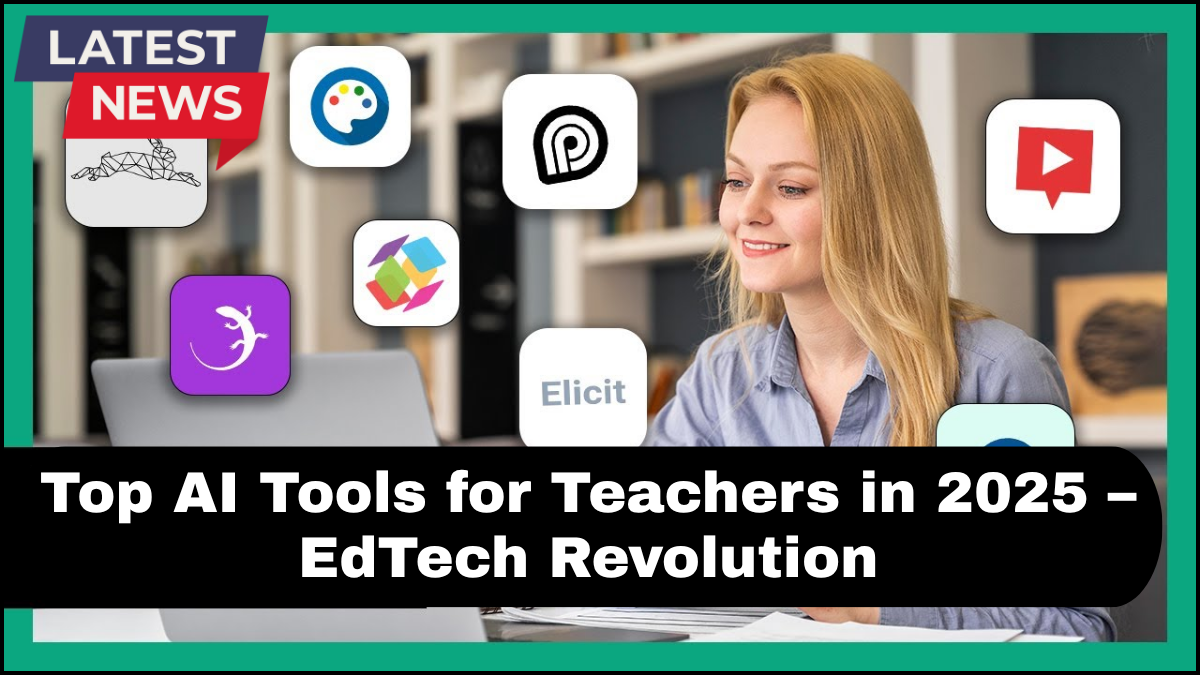The role of educators is evolving rapidly, and 2025 is shaping up to be a landmark year for technological transformation in the classroom. With artificial intelligence reshaping how we teach and learn, teachers now have access to powerful AI-driven platforms that simplify administrative tasks, personalize instruction, and increase student engagement. This article explores the top AI tools for teachers in 2025, highlighting how these EdTech solutions are redefining education.

1. Socratic by Google – Instant Student Support and Instructional Aid
Google’s Socratic continues to lead as a powerful AI teaching assistant in 2025. It uses natural language processing and image recognition to help students get step-by-step solutions across subjects like math, science, and literature. Teachers benefit by directing students to this tool for guided self-learning, reducing the time spent on repetitive explanations and allowing more focus on conceptual teaching.
Key Features:
-
AI-powered homework help
-
Visual explanations and concept breakdowns
-
Seamless mobile integration
Socratic supports differentiated learning by enabling students to work independently, at their own pace, while teachers oversee progress using classroom dashboards.
2. Gradescope – Smarter Grading, Less Burnout
Manual grading is one of the most time-consuming aspects of teaching. Gradescope, powered by AI, revolutionizes the grading process by automating evaluations of both multiple-choice and written assignments. In 2025, it’s smarter than ever—with improved optical character recognition and AI pattern detection that learns each teacher’s grading style.
Benefits for Teachers:
-
Auto-grading for assignments and exams
-
Customizable rubrics
-
Detailed analytics to track student performance
By using this tool, educators can save hours each week while maintaining grading accuracy and fairness.
3. Khanmigo by Khan Academy – The AI Tutor and Teaching Assistant
Khanmigo, a GPT-powered assistant integrated into Khan Academy, offers one-on-one tutoring for students and support for teachers. It helps in planning lessons, creating quizzes, and even simulating classroom discussions.
What Sets It Apart:
-
Conversational AI designed specifically for education
-
Ethical AI usage with safety checks
-
Tools for formative assessment and feedback
This AI tool not only personalizes learning for students but also acts as a co-pilot for educators, providing real-time teaching resources.
4. Curipod – AI-Powered Lesson Creation Tool
Teachers often spend hours creating engaging lesson plans and presentations. Curipod simplifies this with AI that can turn a learning objective into an interactive lesson in minutes. By 2025, it offers even deeper customization and integrations with learning management systems (LMS).
Standout Features:
-
Instant generation of interactive slides
-
Built-in formative assessment tools
-
Student participation and polling features
Curipod supports more inclusive classrooms by designing content that caters to different learning styles.
5. MagicSchool AI – All-in-One Educator Toolkit
MagicSchool AI is designed by teachers, for teachers, offering over 60 AI tools specifically built to reduce teacher workload. From IEP writing to classroom management strategies, it’s a centralized hub that saves time and enhances planning.
Top Functions:
-
AI-generated classroom resources
-
Tools for behavior management and SEL
-
Differentiation support for diverse learners
It stands out in 2025 for its educator-centric design and data privacy focus, making it one of the most trusted AI tools for teachers.
6. Otter.ai – Real-Time Transcription and Notes for Classrooms
Otter.ai isn’t new, but in 2025 it’s become a staple for teachers managing hybrid or flipped classrooms. It uses AI to transcribe lessons, capture notes, and even summarize meetings or parent conferences.
Why Teachers Love It:
-
Automatic transcription with speaker identification
-
Integration with Zoom, Google Meet, and Microsoft Teams
-
Searchable and shareable notes
Otter.ai supports inclusive education by aiding students with auditory processing challenges and those who need transcripts to reinforce learning.
7. Diffit – AI for Differentiated Reading Materials
Diffit uses AI to convert any text—web page, article, or video transcript—into reading materials tailored to different grade levels and learning needs. In 2025, it features enhanced translation tools and multimodal support, perfect for multilingual classrooms.
Core Uses:
-
Leveling texts for accessibility
-
Creating reading comprehension questions
-
Integrating with literacy platforms
Diffit ensures all students can access complex content without compromising comprehension or engagement.
Why AI Tools for Teachers in 2025 Matter More Than Ever
As classrooms become more diverse and learning needs more complex, these AI tools for teachers in 2025 are not just helpful—they’re essential. They streamline administrative work, personalize education, and support teachers in delivering high-quality instruction. The EdTech solutions discussed here go beyond automation—they empower educators to focus on what they do best: inspiring and educating students.
FAQs: AI Tools for Teachers in 2025
Q1: Are AI tools replacing teachers?
A: No. AI tools are designed to support—not replace—teachers. They automate repetitive tasks, assist with planning, and personalize learning, allowing teachers to spend more time on student interaction and instructional strategies.
Q2: How do AI tools support differentiated learning?
A: Tools like Diffit and Khanmigo adapt content to student ability levels and provide targeted practice, making it easier to address diverse learning needs within the same classroom.
Q3: Are these AI tools safe to use with student data?
A: Leading platforms prioritize data privacy and are FERPA-compliant. Always verify the tool’s data security policies before integrating them into your classroom.
Q4: Can AI tools help with special education needs?
A: Yes. Tools like MagicSchool AI and Otter.ai support IEP creation, speech-to-text, and accessibility features that enhance learning for students with special needs.
Q5: What’s the biggest advantage of using AI in education?
A: Efficiency and personalization. Teachers can manage tasks faster and tailor instruction to individual learners, which boosts both engagement and outcomes.
click here to learn more